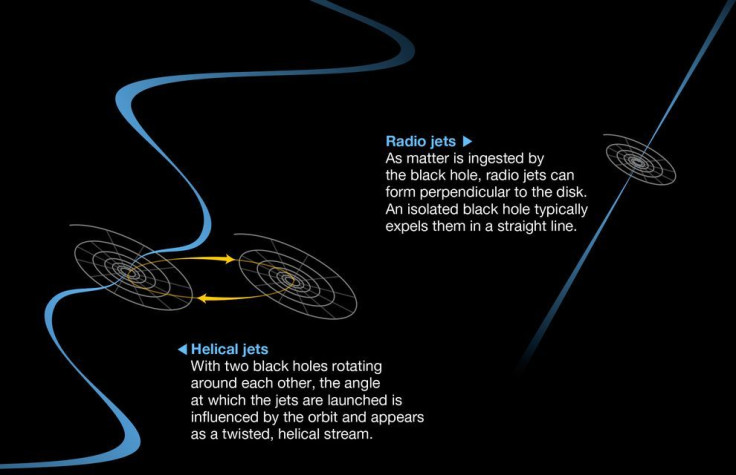Scientists Discover 3 Closely Orbiting Supermassive Black Holes In Distant Galaxy

A team of scientists has discovered a trio of supermassive black holes, closely orbiting the center of a distant galaxy more than four billion light years away from Earth.
Examining six galaxies, the scientists spotted the three supermassive black holes in one of those systems. According to them, this is the “tightest trio of black holes” ever discovered -- with two of the black holes orbiting each other like binary stars -- at such a great distance. The new discovery is expected to help astronomers in their search for gravitational waves, a phenomenon predicted by Einstein.
“What remains extraordinary to me is that these black holes, which are at the very extreme of Einstein's Theory of General Relativity, are orbiting one another at 300 times the speed of sound on Earth,” Roger Deane from the University of Cape Town and the study’s lead author said, in a statement.
According to the study, published in the journal Nature, “closely-packed” supermassive black holes, similar to the ones in question, are surprisingly common in the universe than previously thought.

Scientists believe that gravitational waves originate among merging black holes and the current study of the tightly-packed black hole trio is expected to provide significant insights into this theory.
“The idea that we might be able to find more of these potential sources of gravitational waves is very encouraging as knowing where such signals should originate will help us try to detect these 'ripples' in spacetime as they warp the Universe,” Matt Jarvis, a professor at Oxford University and the study’s co-author, said in the statement.
As part of the study, the scientists used a technique called Very Long Baseline Interferometry, or VLBI, to discover the inner two black holes in the system. The discovery was made by using the European VLBI Network, which includes a set of European, Chinese, Russian and South African antennas.
While very little is known about closely orbiting black holes emitting detectable gravitational waves, scientists believe that future radio telescopes will help astronomers study such celestial systems in exquisite detail, allowing them to better understand how black holes shape galaxies.
“This exciting discovery perfectly illustrates the power of the VLBI technique, whose exquisite sharpness of view allows us to see deep into the hearts of distant galaxies,” Keith Grainge of the University of Manchester said, in the statement.
© Copyright IBTimes 2025. All rights reserved.






















